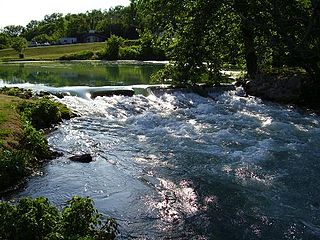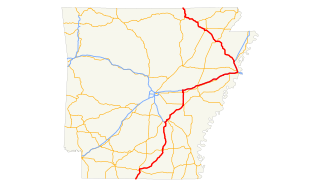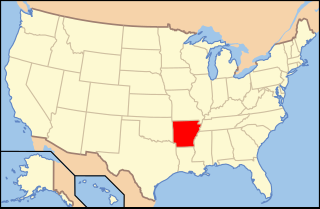See also
- Mammoth Hot Springs, in Yellowstone National Park
- Mammoth (disambiguation)
Mammoth Spring is a large karst spring in the U.S. state of Arkansas.
Mammoth Spring may also refer to:
Madison may refer to:
Wildwood and Wild Wood may refer to:
Spring Lake may refer to:
Hot Springs may refer to:

Salem is the county seat of Fulton County, Arkansas, United States. Salem was first incorporated in 1900. As of the 2010 census the population stood at 1,635.
The Spring River is a 57-mile (92 km) long river which flows through the U.S. states of Missouri and Arkansas. It consists of two branches, the South Fork of the Spring River and the Spring River proper. The South Fork of the Spring River starts in Howell County, Missouri and flows south through Fulton and Sharp counties in Arkansas. The South Fork of the Spring River joins the Spring River proper near the town of Hardy, Arkansas. The South Fork is a quiet stream with gravelly bars that are ideal for camping.

Mammoth Spring is a large, first magnitude karst spring that arises in the Ozark Plateau within the state of Arkansas. It is the largest spring in Arkansas and the third-largest spring within the Ozark Plateau region behind Big Spring and Greer Spring. Mammoth Spring is the seventh-largest natural spring in the world.

Mammoth Spring State Park is a 62.5-acre (25.3 ha) Arkansas state park in Fulton County, Arkansas in the United States. The park is located surrounding National Natural Landmark of the same name to provide recreation and interpretation for visitors. The park offers fishing, boating and hiking in addition to an Arkansas Welcome Center and restored 1886 St. Louis–San Francisco Railway (Frisco) depot operating as a railroad museum. The site became a state park in 1957, but the park continued to add area until 1975.
Whitehall is a street in central London.
Wyandotte may refer to:
Willow Park may refer to:
Blue Springs can refer to:
A Mammoth is an extinct mammal and close relative to the modern elephant.
Morris House or Morris Farm may refer to:
Park Hotel may refer to:

U.S. Route 63 is a north-south U.S. highway that begins in Ruston, LA. In the US state of Arkansas the highway enters the state from Louisiana concurrent with US 167 in Junction City. The highway zigzags through the state serving the major cities of Pine Bluff, West Memphis and Jonesboro. The highway exits the state at Mammoth Spring traveling into Missouri.

Highway 9 is a designation for two north–south state highways in Arkansas. A southern segment of 51.44 miles (82.78 km) begins at U.S. Route 79 at Eagle Mills and heads north to U.S. Route 67 in Malvern before terminating. The northern segment of 174.17 miles (280.30 km) runs from AR 5 to U.S. Route 63 in Mammoth Spring. The route was created during the 1926 Arkansas state highway numbering, and has seen only minor extensions and realignments since. Pieces of both routes are designated as Arkansas Heritage Trails for use during the Civil War and the Trail of Tears.
Hot Springs Historic District may refer to:
Deep Lake is the name of many lakes. Lakes by this name include:

Paleontology in Arkansas refers to paleontological research occurring within or conducted by people from the U.S. state of Arkansas. The fossil record of Arkansas spans from the Ordovician to the Eocene. Nearly all of the state's fossils have come from ancient invertebrate life. During the early Paleozoic, much of Arkansas was covered by seawater. This sea would come to be home to creatures including Archimedes, brachiopods, and conodonts. This sea would begin its withdrawal during the Carboniferous, and by the Permian the entire state was dry land. Terrestrial conditions continued into the Triassic, but during the Jurassic, another sea encroached into the state's southern half. During the Cretaceous the state was still covered by seawater and home to marine invertebrates such as Belemnitella. On land the state was home to long necked sauropod dinosaurs, who left behind footprints and ostrich dinosaurs such as Arkansaurus.